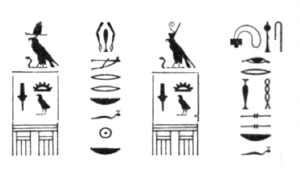Shepseskara - the pharaoh of ancient Egypt , who ruled approximately 2465 - 2460 BC. e. [1] ; from the V dynasty.
| Pharaoh of Ancient Egypt | |
Shepsescar | |
|---|---|
 Image from Shepseskar's bronze cylindrical seal bearing his choir name Sehem-How. Figure Egyptologist Georges Émile Jules Daressy | |
| Dynasty | V dynasty |
| Historical period | Ancient kingdom |
| Predecessor | Neferirkara Kakai |
| Successor | Neferefra |
| Chronology |
|
Content
Shepseskar Board
Board Time
Shepseskar’s name is preserved in the Sakkar list of pharaohs; there he is between Neferirkar and Hainferra ( Neferefra ). Abydos list does not mention it at all. It is evident that he calls him Manefon Sisires and says that he reigned for 7 years. [2]
The royal papyrus of Turin also gives Shepseskar 7 years of rule. True, in the Turin papyrus his name has not been preserved, and only the number of years of his rule is known. However, judging by the small number of inscriptions left over from the reign of this king and the unfinished pyramid, it seems that the reign of this pharaoh could hardly exceed 1 year. And indeed, two cylindrical and several more clay seals found at the site of his intended burial in Abusir are all that survived from this pharaoh.
The seals with his choral name Choir Sehem-how were discovered in 1982 in the oldest part of the Neferefra temple, which was not completed during Neferefr's life. From this it is concluded that Shepseskar could rule after Neferefra, and the sequence of pharaohs was later confused, in the period of dynastic confusion.
In his stele, the nobleman V of the Khau-Ptah dynasty (Khau-Ptah) lists a continuous chain of pharaohs whom he served, namely: Sahur , Neferirkar , Neferefra and Niuserra . As we can see, Shepseskar is not mentioned here at all between Neferirkar and Niuserra, which also suggests that he was misplaced in later lists or, at least, had so few rules that he didn’t even bother to mention his contemporaries.
Pharaoh's Names
| Name type | Hieroglyphic writing | Transliteration - Russian-language oglasovka - Translation | ||||||||||||||||||||
| " Choir name " (like a choir ) | sḫm-ḫˁw - sekhem-how "The ruler in his ascent" | |||||||||||||||||||||
| " Throne name " (as king of Upper and Lower Egypt) | [šp] ss-kȝ- [Rˁ] - shep [ses] -ka- [Ra] - "The Noble Soul of Ra " (badly damaged, reconstruction) | |||||||||||||||||||||
| špss-kȝ-Rˁ | ||||||||||||||||||||||
| " Personal Name " |
| nṯr (?) - wsr (w) - not-useer (y) - "Strong by God / Gods" | ||||||||||||||||||||
Shepseskar Pyramid
Shepseskar is attributed to the unfinished (or rather, just started) pyramid north of the pyramid of Sahur. No evidence to support this exists; this same pyramid is attributed by some historians and Menkauhora , another pharaoh of the V dynasty, whose pyramid was also not identified. Work on the construction of this pyramid was interrupted literally one or two months after the start. In fact, the place under the pyramid was simply leveled, and the digging of a mine for the construction of underground burial chambers had just begun. Based on the fact that, according to many modern documents of the time, the Menkauhora pyramid was probably completed and, most likely, was located in Saqqara or Dakhshur, the unfinished pyramid in Abusira can be attributed with sufficient confidence to Shepseskar.
Traditionally, the rule of Shepseskar is located between the pharaohs of Nepherikar Kakai and Neferefr . However, on the basis of the above, a hypothesis is advanced that contradicts the established ideas about this pharaoh: it assumes that Shepseskar did not precede, but inherited Neferefre. Shepseskar could be the son of Sahur (as the proximity of their pyramids could tell), who seized power after the sudden death of Neferefr. Perhaps he was married to Nimaathap II, whose mastaba is located in the west of the necropolis of Giza (G 4712).
However, Shepseskar could not resist the throne, and after several months of rule Niuserra , the younger brother of Neferefre and Neferirkar's son from Queen Hentkaus II, was removed. The overthrow of Shepseskar may explain why Nimaathap was buried in Giza, and not in Abusir.
| V dynasty | ||
| Predecessor: Neferirkar Cocoa | pharaoh of egypt OK. 2463 - 2456 BC. er (reigned about 7 years) | Successor: Neferefra |
Notes
- ↑ 2438 - 2431 (selon Allen and Beckerath); 2465 - 2460 (selon Krauss); 2483 - 2475 (Selon Redford); 2425 - 2418 (selon Málek); 2442 - 2435 (selon Dodson)
- ↑ Manetho . Egypt. Book I, V Dynasty
Literature
- Weigall A. The History of the Pharaohs. The ruling dynasties of the early, ancient and middle kingdom of Egypt. 3000-1800 BC / Per. from English I. B. Kulikova. - M .: CJSC Tsentrpoligraf, 2018. - 351 p. - 2000 copies - ISBN 978-5-9524-5259-9 .
- Zamorovsky V. Their Majesties of the Pyramid / Trans. from the Slovak OI Malevich. - M .: The main editorial board of the oriental literature of the publishing house “Nauka”, 1981. - 447 p. - (In the wake of the disappeared cultures of the East). - 15 000 copies
- History of the Ancient East. The origin of the most ancient class societies and the first centers of slaveholding civilization. Part 2. Front Asia. Egypt / Edited by G. M. Bongard-Levin . - M .: The main editorial board of the oriental literature of the publishing house “ Nauka ”, 1988. - 623 p. - 25 000 copies
- Ancient East and antiquity . // The rulers of the world. Chronological genealogical tables on world history in 4 vols. / Compiled by V. V. Erlikhman . - T. 1.
Links
- Egyptian History: dynasties 3-5 (inaccessible link) . Absolute Egyptology . The appeal date is April 19, 2009. Archived April 17, 2009.